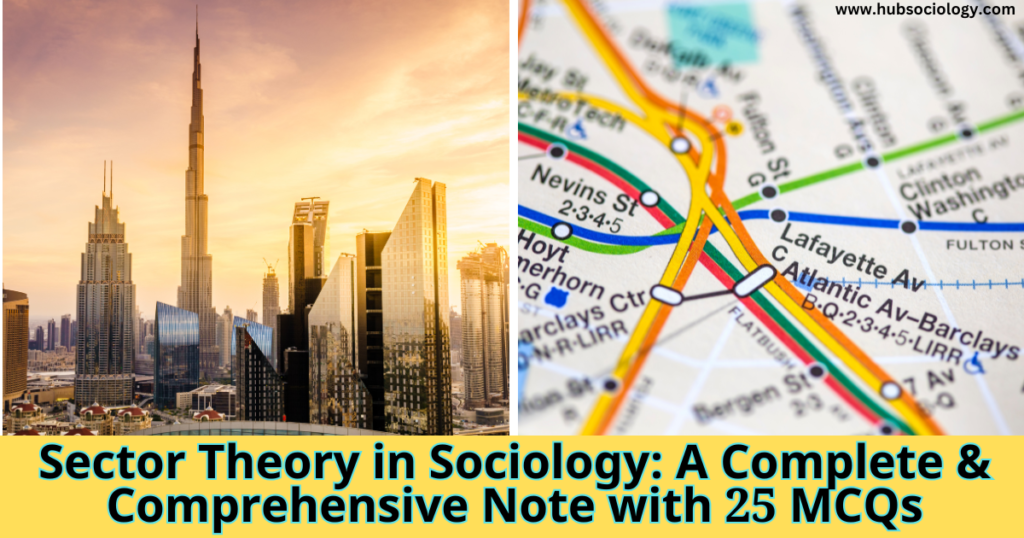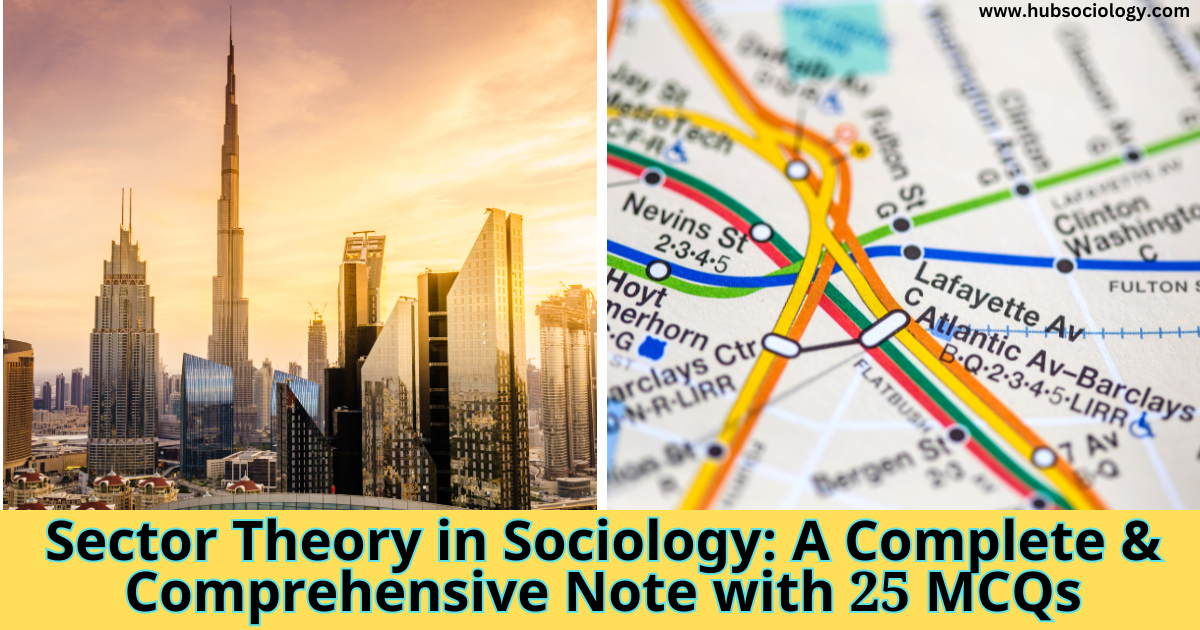
Sector theory, while commonly associated with urban planning and economic geography, also holds significant value in the field of sociology. This theory provides insights into the structural organization of human activities, societal development, and the evolving relationship between spatial and social systems. By analyzing sector theory from a sociological perspective, we can better understand how societies organize themselves, adapt to changes, and respond to external and internal pressures.
This article delves into sector theory’s origins, its sociological relevance, key principles, real-world applications, and critiques, providing a comprehensive view of its importance in understanding social structures and processes.

Historical Origins of Sector Theory
Sector theory originated in the realm of urban geography and economics with Homer Hoyt’s seminal work in 1939. Hoyt proposed that urban growth does not occur in concentric circles, as posited by the concentric zone model, but rather in pie-shaped sectors radiating outward from a central point. Each sector represented distinct economic or social characteristics, such as residential zones, industrial areas, and commercial districts.
Sociologists, recognizing the spatial and hierarchical nature of human societies, adopted and adapted this concept to study the organization and stratification of social systems. The theory’s emphasis on spatial differentiation aligns with sociological inquiries into how geography, class, and culture influence social behavior and institutions.
Key Principles of Sector-Theory in Sociology
In sociology, sector theory is not limited to urban planning but extends to analyzing the broader dynamics of social stratification, resource allocation, and cultural zones. Here are its core principles:
- Spatial Differentiation:
- Human societies often organize themselves spatially based on economic, social, or cultural factors. For instance, urban neighborhoods might develop distinct identities due to shared ethnicities, socioeconomic statuses, or occupations.
- Hierarchical Organization:
- This theory highlights how societies create hierarchical structures that dictate access to resources, opportunities, and power. These hierarchies are often reflected in spatial arrangements, such as affluent suburbs versus underprivileged inner-city areas.
- Influence of External Forces:
- External factors, including globalization, migration, and technological advancements, play a significant role in shaping social sectors. Sociological applications of sector theory examine how these forces influence societal organization and interaction.
- Dynamic Evolution:
- Sectors within societies are dynamic, evolving over time due to economic shifts, policy changes, or cultural transformations. Sociological studies often focus on how these changes impact social cohesion, mobility, and inequality.
Sociological Applications of Sector Theory
Urban Sociology
This theory is particularly relevant in urban sociology, where it helps explain the distribution of social groups within cities. For instance, sociologists use this framework to analyze residential segregation, gentrification, and the spatial concentration of poverty. By understanding how urban sectors form and evolve, policymakers can address issues like housing inequality and urban sprawl.
Social Stratification and Inequality
Sector-theory provides a lens to study social stratification, emphasizing how geographic divisions often mirror economic and social inequalities. Wealthier groups tend to occupy sectors with better infrastructure and services, while marginalized communities are often relegated to areas with fewer resources. This spatial dimension of inequality is crucial in addressing systemic disparities.

Cultural Sociology
Cultural zones within societies often develop as sectors, shaped by shared traditions, languages, or religions. Sector theory helps sociologists examine how these cultural divisions influence social interactions, identity formation, and intergroup relations. For example, the creation of ethnic enclaves in multicultural cities reflects sectoral dynamics driven by cultural affinity and social networks.
Migration and Demographic Changes
Migration patterns frequently result in the reorganization of social sectors. Immigrant communities often establish themselves in specific areas, creating new social and cultural sectors within existing structures. Sector theory aids in understanding how these shifts impact societal cohesion and integration.
Work and Economic Systems
The division of labor and the spatial organization of industries align with the principles of sector theory. Sociologists study how economic sectors—such as agriculture, manufacturing, and services—influence social organization and mobility. The theory also sheds light on the interplay between workplace geography and social dynamics, such as commuting patterns and urban-rural disparities.
Real-World Examples of Sector Theory in Sociology
- Gentrification in Urban Centers:
- Gentrification, the process of affluent groups moving into traditionally lower-income areas, exemplifies sector theory in action. As new sectors emerge, they often displace existing residents, leading to social tensions and reshaping community identities.
- Ethnic Enclaves in Global Cities:
- Neighborhoods like Chinatown in San Francisco or Little Italy in New York demonstrate how cultural and ethnic sectors form and persist within diverse urban settings. These enclaves provide social support and preserve cultural heritage but also face challenges related to assimilation and economic pressures.
- Suburbanization and Urban Sprawl:
- The growth of suburban sectors reflects shifts in societal values, such as the desire for homeownership and access to better schools and amenities. However, this trend often exacerbates social inequalities and environmental concerns.
- Industrial Decline and Social Dislocation:
- The decline of manufacturing sectors in cities like Detroit highlights how economic changes disrupt social structures. Sociologists analyze these shifts to understand their impact on unemployment, crime, and community resilience.
- Smart Cities and Digital Sectors:
- The rise of smart cities introduces new sectors defined by technological innovation and digital connectivity. These developments raise questions about access, surveillance, and the digital divide, which sociologists explore through the lens of sector theory.
Critiques and Limitations of Sector Theory
Sector-theory offers valuable perspectives but has notable critiques and limitations, particularly when applied to sociological contexts:
- Oversimplification:
- Sector-theory tends to oversimplify complex social dynamics by prioritizing spatial factors over other dimensions of societal organization. Social behaviors, cultural practices, and systemic inequalities often operate independently of physical geography.
- Neglect of Intersectionality:
- Critics highlight the theory’s inability to account for intersecting identities such as race, gender, and class. These overlapping factors often play a critical role in determining access to resources and shaping experiences within societal sectors.
- Static Models:
- Early formulations of sector theory depict a static view of social and spatial structures, failing to capture the fluid, dynamic nature of modern societies. Sociological realities often involve rapid changes due to technological advancements, economic crises, or policy shifts.
- Eurocentrism:
- The theory’s origins in Western urban contexts may limit its relevance in non-Western societies. Different cultural norms, economic systems, and historical trajectories challenge the universal applicability of sector theory.
- Environmental Oversight:
- The human-centric focus of sector theory often neglects environmental considerations. Urban expansion, resource exploitation, and spatial organization have significant ecological consequences that the theory fails to adequately address.
- Technological Changes:
- With the rise of virtual spaces and digital connectivity, the physical boundaries emphasized in sector theory are becoming less relevant. Modern societies increasingly operate in both physical and virtual domains, complicating traditional spatial analyses.
Future Directions and Relevance
Despite its limitations, this theory remains a foundational framework for sociological analysis. Its relevance can be enhanced by addressing current societal challenges and integrating interdisciplinary approaches. Below are some key future directions:
- Incorporating Intersectionality:
- Future adaptations of sector theory should incorporate intersectional analysis to account for the ways race, gender, class, and other identities interact with spatial organization. This would provide a more nuanced understanding of societal dynamics.
- Addressing Digital Transformations:
- The rise of virtual sectors, such as online communities and digital economies, necessitates an expansion of the theory to include cyberspace as a critical component of societal organization. Sociologists can explore how digital connectivity influences social mobility, inequality, and cultural identity.
- Integrating Environmental Perspectives:
- Future research should focus on the relationship between spatial organization and environmental sustainability. Examining how societal sectors impact ecological systems can inform policies aimed at balancing development with conservation.
- Global Applicability:
- Adapting the theory to diverse cultural and economic contexts, especially in the Global South, will enhance its relevance. For example, urbanization patterns in Asia and Africa differ significantly from Western models and require context-specific analysis.
- Dynamic Modeling:
- Sociologists should develop dynamic models that reflect the ever-changing nature of societies. Incorporating temporal changes, such as migration patterns or economic cycles, can make the theory more adaptable to contemporary realities.
- Interdisciplinary Collaboration:
- Collaborating with fields like environmental science, technology studies, and cultural anthropology can broaden the scope of sector theory. Interdisciplinary approaches can address its current limitations and offer holistic insights into societal organization.
- Policy Implications:
- By refining sector theory, sociologists can provide actionable insights for policymakers. For instance, understanding how spatial inequalities develop and persist can guide urban planning, housing policies, and social welfare initiatives.
Conclusion
Sector-theory, when viewed through a sociological lens, offers profound insights into the spatial and social organization of human societies. Its principles help elucidate the complexities of urbanization, inequality, cultural diversity, and economic systems. While the theory has its limitations, ongoing adaptations and interdisciplinary approaches ensure its continued relevance in addressing contemporary social challenges. By embracing sector theory’s potential, sociologists can contribute to creating more equitable and inclusive societies that account for the dynamic interplay of space, culture, and social structure.
MCQs
1. Who originally proposed the Sector-Theory?
a) Ernest Burgess
b) Homer Hoyt
c) Max Weber
d) Emile Durkheim
Answer: b) Homer Hoyt
2. Sector-Theory primarily focuses on which aspect of urban growth?
a) Circular expansion
b) Sectoral development
c) Random distribution
d) Centralized hierarchy
Answer: b) Sectoral development
3. In sociology, Sector-Theory is applied to study:
a) Natural ecosystems
b) Urban and social stratification
c) The spread of diseases
d) Religious institutions only
Answer: b) Urban and social stratification
4. What is a core principle of Sector Theory in sociology?
a) Spatial differentiation
b) Homogeneous development
c) Uniform distribution of resources
d) Elimination of hierarchies
Answer: a) Spatial differentiation
5. According to Sector Theory, wealthier groups typically occupy which sectors?
a) Industrial zones
b) Areas with better infrastructure
c) Peripheral rural areas
d) Shared community spaces
Answer: b) Areas with better infrastructure
6. Sector Theory originated in which year?
a) 1919
b) 1929
c) 1939
d) 1949
Answer: c) 1939
7. What is a major critique of Sector Theory?
a) It overcomplicates social dynamics
b) It oversimplifies social complexities
c) It focuses too much on virtual spaces
d) It ignores all spatial factors
Answer: b) It oversimplifies social complexities
8. Which urban phenomenon is an example of Sector Theory in practice?
a) Suburbanization
b) Global warming
c) Technological innovations
d) Ocean pollution
Answer: a) Suburbanization
9. What does Sector Theory fail to address adequately?
a) Spatial inequalities
b) Intersecting identities like race and gender
c) Urban sprawl
d) Economic cycles
Answer: b) Intersecting identities like race and gender
10. What is the focus of Sector-Theory in cultural sociology?
a) Formation of cultural zones
b) Elimination of cultural differences
c) Encouraging cultural homogeneity
d) Reducing migration
Answer: a) Formation of cultural zones
11. The decline of manufacturing sectors in cities like Detroit highlights which aspect of Sector Theory?
a) Static models
b) Sectoral dislocation due to economic changes
c) Environmental impact of sectors
d) Elimination of hierarchies
Answer: b) Sectoral dislocation due to economic changes
12. How does Sector Theory relate to migration?
a) It discourages migration
b) It explains the formation of new social and cultural sectors
c) It eliminates cultural differences
d) It prevents integration
Answer: b) It explains the formation of new social and cultural sectors
13. What is one future direction for Sector-Theory?
a) Ignoring digital transformations
b) Developing dynamic models
c) Focusing only on static urban areas
d) Eliminating environmental considerations
Answer: b) Developing dynamic models
14. Sector Theory is limited by its:
a) Universal applicability
b) Eurocentric origins
c) Interdisciplinary approaches
d) Inclusion of intersectionality
Answer: b) Eurocentric origins
15. What is a key feature of suburbanization as per Sector Theory?
a) Urban decay
b) Access to better amenities and schools
c) Centralized poverty
d) Decline in homeownership
Answer: b) Access to better amenities and schools
16. Which of the following is an example of a cultural sector?
a) Financial districts
b) Ethnic enclaves like Chinatown
c) Industrial zones
d) Digital marketplaces
Answer: b) Ethnic enclaves like Chinatown
17. A critique of Sector-Theory is its neglect of:
a) Spatial organization
b) Environmental consequences
c) Social hierarchy
d) Economic factors
Answer: b) Environmental consequences
18. Sector Theory’s hierarchical structure is evident in:
a) Equal resource distribution
b) Affluent suburbs vs. underprivileged areas
c) Random population spread
d) Cultural unification
Answer: b) Affluent suburbs vs. underprivileged areas
19. Which is a real-world example of sectoral digitalization?
a) Smart cities
b) Ethnic enclaves
c) Agricultural zones
d) Manufacturing hubs
Answer: a) Smart cities
20. Why is Sector Theory criticized as static?
a) It overemphasizes technology
b) It fails to capture societal changes
c) It changes frequently
d) It incorporates environmental aspects
Answer: b) It fails to capture societal changes
21. What should Sector Theory incorporate for future relevance?
a) Static models
b) Cultural homogeneity
c) Environmental perspectives
d) Economic isolation
Answer: c) Environmental perspectives
22. A limitation of early Sector-Theory is:
a) Ignoring spatial patterns
b) Failing to consider intersecting identities
c) Focusing on non-hierarchical organization
d) Overemphasizing ecology
Answer: b) Failing to consider intersecting identities
23. What is a policy implication of Sector Theory?
a) Creating more digital spaces
b) Designing targeted housing and urban plans
c) Eliminating hierarchical systems
d) Promoting social isolation
Answer: b) Designing targeted housing and urban plans
24. Sector Theory helps sociologists understand:
a) Climate patterns
b) Urbanization and inequality
c) Cybersecurity systems
d) Random migration
Answer: b) Urbanization and inequality
25. What does the term “spatial differentiation” mean in Sector Theory?
a) Uniform geographic distribution
b) Societal organization based on physical and cultural factors
c) Complete elimination of hierarchies
d) Neglect of geographic factors
Answer: b) Societal organization based on physical and cultural factors
Related questions
5-Mark Questions
These are concise questions that require brief and focused answers.
- Define Sector-Theory in sociology.
- What are the key principles of Sector Theory?
- Name two critiques of Sector-Theory.
- How does Sector Theory explain urban social stratification?
- Give two real-world examples of Sector Theory in action.
- What is spatial differentiation, and why is it important in Sector-Theory?
- Mention two applications of Sector Theory in urban sociology.
- Explain the role of migration in forming new social sectors.
- How does Sector-Theory relate to the concept of gentrification?
- Identify one limitation of Sector Theory regarding environmental concerns.
10-Mark Questions
These require more detailed explanations, examples, and clarity.
- Discuss the origins of Sector Theory and its adaptation in sociology.
- Explain the concept of hierarchical organization within Sector Theory.
- Analyze how Sector Theory helps in understanding cultural zones.
- How does Sector Theory address social inequality? Provide examples.
- What are the main critiques of Sector-Theory in sociology?
- How has globalization influenced the relevance of Sector Theory?
- Explain the implications of Sector-Theory on urban planning and policy-making.
- Describe how Sector Theory applies to the phenomenon of suburbanization.
- Discuss the impact of technological advancements on social sectors.
- What role does Sector-Theory play in analyzing social stratification in urban areas?
15-Mark Questions
These demand an in-depth analysis with examples, critical viewpoints, and elaboration.
- Critically evaluate the strengths and limitations of Sector Theory in sociology.
- How does Sector Theory explain urban growth and its impact on social structures?
- Discuss the real-world applications of Sector Theory in understanding societal organization.
- Examine the role of Sector Theory in studying the spatial and social dynamics of migration.
- How does Sector Theory contribute to the understanding of inequality and resource allocation?
- Discuss how Sector Theory can be adapted to address digital transformations and virtual spaces.
- Analyze the interplay between Sector Theory and environmental sustainability in the modern context.
- How has Sector Theory evolved over time to remain relevant in diverse global contexts?
- Compare and contrast Sector Theory with other sociological models like the concentric zone model.
- What future directions should Sector Theory take to address contemporary urban and social challenges?

